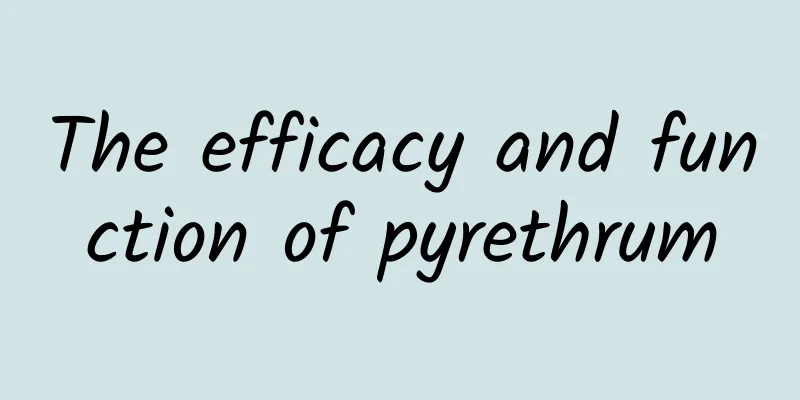The efficacy and function of pyrethrum

|
The traditional Chinese medicine pyrethrum is a relatively good medicinal material, but many people don’t know much about it. So let’s take a closer look at the traditional Chinese medicine pyrethrum. [Source] Medicinal material source: the inflorescence and whole herb of Pyrethrum cineraria, a plant of the Asteraceae family. [Original form] Pyrethrum is a perennial herb, 20-60cm tall. The whole plant is light silver-gray, with appressed T-shaped hairs or short soft hairs forked at the tips. Leaves are alternate, silvery gray, with glandular dots; basal leaves are up to 20 cm long, 1-2 cm wide, ovate or elliptical, pinnate-lobed along the winged rachis, first pinnae are pinnate or palmate and then shallowly to deeply lobed, the last pinnae are linear or oblong-ovate, with obtuse or short acuminate tips. Inflorescence capitulate, solitary or arranged in sparse umbels; involucral bracts about 4 layers; ligulate flowers white, truncate or slightly concave at apex; tubular flowers yellow. Achenes have longitudinal ridges, coronal pappus not less than 1mm, edges truncated or with missing teeth. Flowering and fruiting period is from May to August. 【Habitat distribution】 Native to Europe. It is cultivated in various regions in the north and south of my country. 【Cultivation】 1. Biological characteristics: It prefers a mild climate and is suitable for growing at a temperature of around 10-25°C. If the temperature exceeds 30°C, plant growth will be inhibited. It is strong and cold-resistant, but afraid of frost. It likes humidity. If the soil is dry, the number of flowers per plant and the yield of dried flowers will be significantly reduced. It prefers neutral or slightly alkaline sandy loam. It is not suitable for planting in clay, low-lying land, or areas with strong acidity or alkalinity. [Properties] Identification of properties: The head inflorescence is oblate, about 1 cm in diameter, with more than 40 bracts, arranged in nearly shingles, in 2-4 layers. Bracts are nearly lanceolate, light yellow-green, and covered with short hairs. The receptacle is oblate, with a layer of ligulate flowers on the edge, 15-30 flowers, female, corolla light yellow, 3-lobed at the tip. The central tubular flowers are 200-300, bisexual, with yellow corolla, 5-lobed apex, 5 stamens, and pappus. It has a slight fragrance and tastes bitter and spicy. : : : : : : : : : : : : : : : [Pharmacological action] Insecticidal effect: Pyrethrum is toxic to many insects such as mosquitoes, flies, bedbugs and cockroaches. Insects become overexcited and lose coordination within 1-2 minutes of exposure to pyrethrins and are rapidly knocked down and paralyzed. However, some insects can recover after one day. Pyrethrum is a typical neurotoxin that acts directly on excitable membranes, interfering with membrane ion conduction, mainly affecting the sodium channels of nerve membranes, delaying the disappearance of increased sodium conduction during excitement, resulting in prolonged transmembrane sodium ion flow, causing repeated activity of sensory nerve fibers and motor nerve axons, transient depolarization of nerve cells and sustained muscle contraction. At high concentrations, it inhibits the ion conduction of nerve membranes and blocks excitement. [Toxicity] Pyrethrum has very low toxicity to mammals when taken orally. It is less toxic to insects and mammals than most other organic pesticides, and is rapidly metabolized in the body, leaving virtually no residue. Pyrethrin is toxic to warm-blooded animals. A subcutaneous injection of 52 mg/kg in rabbits can cause death within 48 hours. 【Nature and flavor】 Bitter; Cool 【Functions and indications】Insecticidal. Mainly used for scabies; also used to kill mosquitoes, flies, fleas, lice, bedbugs; also used as agricultural insecticide 【Usage and Dosage】 For external use: grind appropriate amount into powder and apply on the affected area. 【Note】 "National Collection of Chinese Herbal Medicines": "This product is often used as a raw material for mosquito coils, and is also available as a powder or emulsion. Sensitive people may develop rashes, rhinitis, asthma, etc. after contact or inhalation. Inhaling too much or swallowing it may cause nausea, vomiting, gastrointestinal colic, diarrhea, headache, tinnitus, nightmares, syncope, etc. Infants may also develop pale complexion and convulsions." 【Excerpt】 Chinese Materia Medica I believe that after reading the above explanations, everyone has a deeper understanding of the Chinese medicine pyrethrum? In fact, many foods or medicinal materials are the same. Only when we understand them can we eat them correctly according to our own situation and effectively help maintain our health. |
<<: The efficacy and function of orpiment
>>: The efficacy and function of Tribulus terrestris
Recommend
The efficacy and function of Ipomoea aquatica[picture]
Speaking of Ipomoea aquatica [picture], many peop...
What are the benefits of drinking dried dandelions in water?
Many people are familiar with dandelions. You can...
The efficacy and function of berberine tablets
Medicine is very common in life. It is very helpf...
The efficacy and function of red ginseng
There are many common Chinese medicinal materials...
String theory in the garden
How to quantize gravity is a puzzle for theoretic...
FIRST INSIGHT: 2021 Consumer Spending Report
First Insight and the Baker Center for Retail at ...
Motherwort pictures and effects
Motherwort granules are a relatively common Chine...
Mycoplasma pneumoniae infection may peak in November: Parents must know these key questions
The health of children concerns every parent. Thi...
The "old man of longevity" in the "mud basin"? Owl: I actually have the same face as the "old man"!
In the fossil exhibition areas of many natural mu...
The efficacy and function of purple leather ear
Purple fungus is a common type of traditional Chi...
The efficacy and effects of sweet grass
In daily life, people are not only very familiar ...
Is adding chlorine to tap water harmful to the body?
We all know that chlorine is a toxic gas with a s...
What does Ai Ye look like?
Mugwort is very common all over China, but some p...
The efficacy and function of snow lotus seeds
Snow lotus seeds are a very precious Chinese medi...
More than 1 million degrees! Why is it hotter the farther away from the sun?
The farther away from a heat source, the cooler t...









